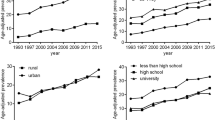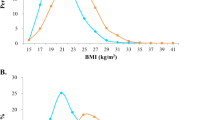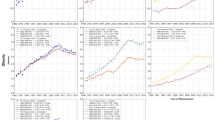Abstract
Objective:
The aim of this study was to examine changes over 5 years in body mass index (BMI) and waist circumference (WC) of adolescents from Ho Chi Minh City by age, gender and household economic status.
Methods:
Anthropometry including height, weight and WC measurements of 759 secondary high school students were collected 1-year apart in a prospective cohort study, between 2004 and 2009. BMI was calculated and overweight/obesity was defined using International Obesity Task Force (IOTF) BMI cutoffs. Abdominal ‘overweight’ and ‘obesity’ were defined as WC >91st–97th and ⩾98th centile, respectively. BMI z-scores were also created.
Results:
Over the 5-year period, the absolute changes in mean BMI and WC were statistically significant (P<0.001). Boys had higher BMI and WC values than girls (P<0.001). The prevalence of overweight and obesity defined by IOTF BMI cutoff values increased gradually from 12.5% and 1.7% in the first year to 16.7% and 5.1% in the last year. Using WC cutoff values, the prevalence of abdominal overweight and obesity increased from 12.9% and 1.8% to 18.5% and 6.6%, respectively. BMI z-score curves shifted towards the right-hand side of the distribution (that is, towards overweight and obesity).
Conclusion:
Overweight and obesity, as measured by BMI or WC, continued to increase among adolescents of Ho Chi Minh City over the 5-year period.
This is a preview of subscription content, access via your institution
Access options
Subscribe to this journal
Receive 12 print issues and online access
$259.00 per year
only $21.58 per issue
Buy this article
- Purchase on Springer Link
- Instant access to full article PDF
Prices may be subject to local taxes which are calculated during checkout

Similar content being viewed by others
References
Trang NH, Hong TK, Dibley MJ, Sibbritt DW . Factors associated with physical inactivity in adolescents in Ho Chi Minh City, Vietnam. Med Sci Sports Exerc 2009; 41: 1374–1383.
Nguyen T, Tang H, Kelly P, van der Ploeg H, Dibley M . Association between physical activity and metabolic syndrome: a cross sectional survey in adolescents in Ho Chi Minh City, Vietnam. BMC Public Health 2010; 10: 141.
Hong TK, Dibley MJ, Sibbritt D, Binh PN, Trang NH, Hanh TT . Overweight and obesity are rapidly emerging among adolescents in Ho Chi Minh City, Vietnam, 2002–2004. Int J Pediatr Obes 2007; 2: 194–201.
Janssen I, Katzmarzyk PT, Ross R . Body mass index, waist circumference, and health risk: evidence in support of Current National Institutes of Health Guidelines. Arch Intern Med 2002; 162: 2074–2079.
Bitsori M, Linardakis M, Tabakaki M, Kafatos A . Waist circumference as a screening tool for the identification of adolescents with the metabolic syndrome phenotype. Int J Pediatr Obes 2009; 4: 325–331.
Kvaavik E, Tell GS, Klepp K-I . Predictors and tracking of body mass index from adolescence into adulthood: follow-up of 18 to 20 years in the Oslo Youth Study. Arch Pediatr Adolesc Med 2003; 157: 1212–1218.
McCarthy HD, Ellis SM, Cole TJ . Central overweight and obesity in British youth aged 11–16 years: cross sectional surveys of waist circumference. BMJ 2003; 326: 624.
Utter J, Scragg R, Denny S, Schaaf D . Trends in body mass index and waist circumference among New Zealand adolescents, 1997/1998–2005. Obes Rev 2009; 10: 378–382.
Li C, Ford ES, Mokdad AH, Cook S . Recent trends in waist circumference and waist–height ratio among US children and adolescents. Pediatrics 2006; 118: e1390–e1398.
Moreno LA, Sarría A, Fleta J, Marcos A, Bueno M . Secular trends in waist circumference in Spanish adolescents, 1995 to 2000–02. Arch Dis Child 2005; 90: 818–819.
Garnett SP, Cowell CT, Baur LA, Shrewsbury VA, Chan A, Crawford D et al. Increasing central adiposity: the Nepean Longitudinal Study of young people aged 7–8 to 12–13 y. Int J Obes Relat Metab Disord 2005; 29: 1353–1360.
Freedman DS, Khan LK, Dietz WH, Srinivasan SR, Berenson GS . Relationship of childhood obesity to coronary heart disease risk factors in adulthood: the Bogalusa Heart Study. Pediatrics 2001; 108: 712–718.
Trang NHHD, Hong TK, Dibley MJ . Cohort profile: Ho Chi Minh City Youth Cohort—changes in diet, physical activity, sedentary behaviour and relationship with overweight/obesity in adolescents. BMJ Open 2012; 2: e000362.
Tang KH, Nguyen HH, Dibley MJ, Sibbritt DW, Phan NT, Tran TM . Factors associated with adolescent overweight/obesity in Ho Chi Minh city. Int J Pediatr Obes 2010; 5: 396–403.
WHO. Expert Committee. Physical status: the use and interpretation of anthropometry: report of a WHO expert committee. World Health Organization: Geneva, 1995. WHO Technical Report Series No. 854.
Norton K, Whittingham N, Carter L, Kerr D, Gore C, M M-J (eds). Measurement Techniques in Anthropometry. UNSW Press: Sydney, 1996.
Tanner JM . Growth at Adolescence; With a General Consideration of the Effects of Hereditary and Environmental Factors Upon Growth and Maturation from Birth to Maturity 2nd edn. Blackwell: Oxford, 1962.
Filmer D, Pritchett LH . Estimating wealth effects without expenditure data—or tears: an application to educational enrollments in states of India. Demography 2001; 38: 115–132.
O O’Donnell, E van Doorslaer, A Wagstaff, M Lindelow . Analyzing Health Equity Using Household Survey Data: A Guide to Techniques and their Implementation. World Bank: Washington, DC, 2008. Report No.: 978-0-8213-6933-3.
Department of Statistics. Report on Economic Status of Populations in Ho Chi Minh City. Bureau of Statistics: Ho Chi Minh City, 2004.
Tuan T, Dung VTM, Neu I, Dibley MJ . Comparative quality of private and public health services in rural Vietnam. Health Policy Plan 2005; 20: 319–327.
Dieu HT, Dibley MJ, Sibbritt D, Hanh TT . Prevalence of overweight and obesity in preschool children and associated socio-demographic factors in Ho Chi Minh City, Vietnam. Int J Pediatr Obes 2007; 2: 40–50.
Cole TJ, Bellizzi MC, Flegal KM, Dietz WH . Establishing a standard definition for child overweight and obesity worldwide: International Survey. BMJ 2000; 320: 1240–1243.
McCarthy H, Jarrett H, Crawley H . The development of waist circumference percentiles in British children aged 5.0–16.9 y. Eur J Clin Nutr 2001; 55: 902–907.
Cole TJ, Faith MS, Pietrobelli A, Heo M . What is the best measure of adiposity change in growing children: BMI, BMI %, BMI z-score or BMI centile? Eur J Clin Nutr 2005; 59: 419–425.
Berkey CS, Colditz GA . Adiposity in adolescents: change in actual BMI works better than change in BMI z score for longitudinal studies. Ann Epidemiol 2007; 17: 44–50.
Laska MN, Murray DM, Lytle LA, Harnack LJ . Longitudinal associations between key dietary behaviors and weight gain over time: transitions through the adolescent years. Obesity (Silver Spring, MD) 2012; 20: 118–125.
Ekblom ÖB, Oddsson K, Ekblom BT . Prevalence and regional differences in overweight in 2001 and trends in BMI distribution in Swedish children from 1987 to 2001. Scand J Public Health 2004; 32: 257–263.
Olds TS, Tomkinson GR, Ferrar KE, Maher CA . Trends in the prevalence of childhood overweight and obesity in Australia between 1985 and 2008. Int J Obes 2009; 34: 57–66.
Ogden CL, Carroll MD, Kit BK, Flegal KM . Prevalence of obesity and trends in body mass index among US children and adolescents, 1999–2010. JAMA 2012; 5: 483–490.
Julia M, van Weissenbruch MM, Prawirohartono EP, Surjono A, Delemarre-van de Waal HA . Tracking for underweight, overweight and obesity from childhood to adolescence: a 5-year follow-up study in urban Indonesian children. Horm Res 2008; 69: 301–306.
Mo-suwan L, Tongkumchum P, Puetpaiboon A . Determinants of overweight tracking from childhood to adolescence: a 5 y follow-up study of Hat Yai schoolchildren. Int J Obes Relat Metab Disord 2000; 24: 1642–1647.
Zhang Y, Wang S . Prevalent change in overweight and obesity in children and adolescents from 1995 to 2005 in Shandong, China. Asia Pac J Public Health 2011; 23: 904–916.
Cui Z, Huxley R, Wu Y, Dibley MJ . Temporal trends in overweight and obesity of children and adolescents from nine Provinces in China from 1991–2006. Int J Pediatr Obes 2010; 5: 365–374.
Olds T, Maher C, Zumin S, Péneau S, Lioret S, Castetbon K et al. Evidence that the prevalence of childhood overweight is plateauing: data from nine countries. Int J Pediatr Obes 2011; 6: 342–360.
Kilpatrick M, Ohannessian C, Bartholomew JB . Adolescent weight management and perceptions: an analysis of the National Longitudinal Study of Adolescent Health. J Sch Health 1999; 69: 148–152.
McElhone S, Kearney JM, Giachetti I, Zunft HJ, Martinez JA . Body image perception in relation to recent weight changes and strategies for weight loss in a nationally representative sample in the European Union. Public Health Nutr 1999; 2: 143–151.
Choi J, Hwang J, Yi J . Acculturation, body perception, and weight status among Vietnamese American students. J Immigr Minor Health 2011; 13: 1116–1124.
Bjornelv S, Lydersen S, Mykletun A, Holmen TL . Changes in BMI-distribution from 1966–69 to 1995–97 in adolescents. The Young-HUNT Study, Norway. BMC Public Health 2007; 7: 279.
Eriksson M, Rasmussen F, Nordqvist T . Changes in shape and location of BMI distributions of Swedish children. Acta Pædiatr 2005; 94: 1558–1565.
Janssen I, Katzmarzyk P, Ross R . Waist circumference and not body mass index explains obesity-related health risk. Am J Clin Nutr 2004; 79: 379–384.
Ng VW, Kong AP, Choi KC, Ozaki R, Wong GW, So WY et al. BMI and waist circumference in predicting cardiovascular risk factor clustering in Chinese adolescents. Obesity (Silver Spring. MD) 2007; 15: 494–503.
Cui Z, Huxley R, Wu Y, Dibley MJ . Temporal trends in overweight and obesity of children and adolescents from nine Provinces in China from 1991–2006. Int J Pediatr Obes 2010; 5: 365–374.
WHO Expert Consultation. Appropriate body-mass index for Asian populations and its implications for policy and intervention strategies. Lancet 2004; 363: 157–163.
Cuong QT . Assessment of the prevalence of obesity and related risk factors in Vietnamese adults living in urban areas of Ho Chi Minh City, Vietnam. Master thesis Univerity of Newcastle: Newcastle, 2004.
Schmitz KE, Hovell MF, Nichols JF, Irvin VL, Keating K, Simon GM et al. A validation study of early adolescents’ pubertal self-assessments. J Early Adolesc 2004; 24: 357–384.
Chan NPT, Sung RYT, Kong APS, Goggins WB, So HK, Nelson EAS . Reliability of pubertal self-assessment in Hong Kong Chinese children. J Paediatr Child Health 2008; 44: 353–358.
Chan N, Sung R, Nelson E, So H, Tse Y, Kong A . Measurement of pubertal status with a Chinese Self-report Pubertal Development Scale. Matern Child Health J 2010; 14: 466–473.
Acknowledgements
We gratefully acknowledge the support by the staff of the Nutrition Centre, Ho Chi Minh City Health Department and all data collectors for their enormous help in data collection, entry and cleaning. The 5-year cohort study was funded by a grant from the Nestlé Foundation, Switzerland. One of the coauthors, Trang Nguyen HHD, received a partial PhD scholarship from The University of Sydney World Scholars and Hoc Mai Foundation, and the University of Sydney.
Author information
Authors and Affiliations
Corresponding author
Ethics declarations
Competing interests
The authors declare no conflict of interest.
Rights and permissions
About this article
Cite this article
Hong, T., Trang, N. & Dibley, M. Changes in adiposity indicators of Ho Chi Minh City adolescents in a 5-year prospective cohort study. Int J Obes 37, 1261–1267 (2013). https://doi.org/10.1038/ijo.2012.217
Received:
Revised:
Accepted:
Published:
Issue Date:
DOI: https://doi.org/10.1038/ijo.2012.217
Keywords
This article is cited by
-
Triceps and subscapular skinfold thickness percentiles of a school-based sample of adolescents in Ho Chi Minh City, Vietnam
European Journal of Clinical Nutrition (2020)
-
Prevalence and incidence of overweight and obesity among Vietnamese preschool children: a longitudinal cohort study
BMC Pediatrics (2017)



